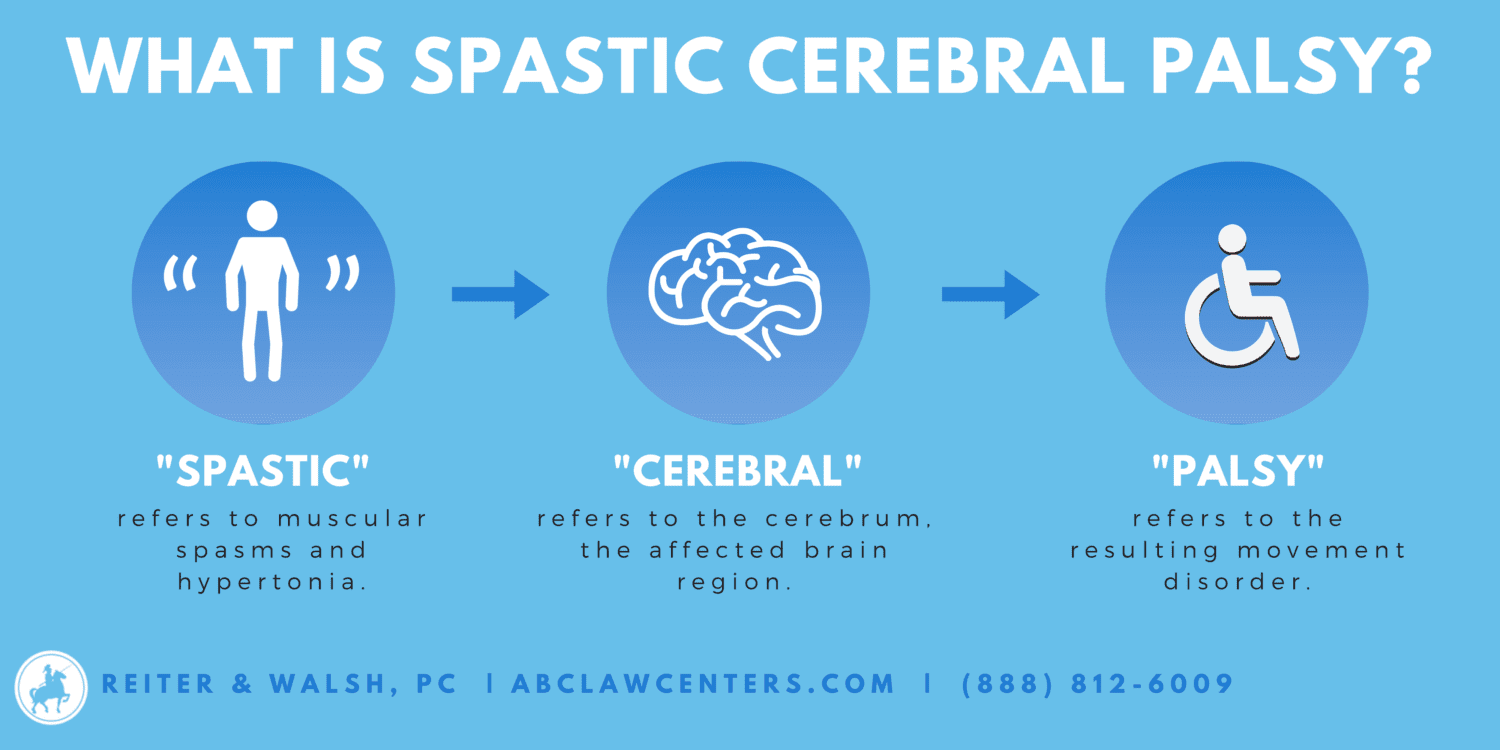Spastic Quadriplegic Cerebral Palsy
What is spastic quadriplegic cerebral palsy?
Spastic quadriplegic cerebral palsy is the most severe form of cerebral palsy. The condition affects all four limbs – both arms and both legs. “Quad” refers to four limbs affected, and “plegic” refers to paralysis.
This type of cerebral palsy is identified under the Gross Motor Function Classification System with Level V. This means the person usually has issues with any voluntary movement. They will need help from adaptive equipment, assistive technology, and a caretaker for mobility.
A child with spastic quadriplegic cerebral palsy will need a caretaker for their lifetime.
Does your child have spastic cerebral palsy?
Preventable birth injuries can lead to severe cerebral palsy. A birth injury lawyer can help secure funds to cover your child’s care for the rest of their life. Call the birth injury attorneys at ABC Law Centers to find out if you have a case.
What is cerebral palsy?
Cerebral palsy (CP) is the most common motor disorder among children. CP is caused by damage to the parts of the brain that affect movement.

What is spastic cerebral palsy?
Spastic cerebral palsy is the most common type of cerebral palsy, affecting approximately 80% of people with CP. It is characterized by stiff muscles and awkward movements. People with spastic cerebral palsy have increased muscle tone and tight muscles.
Is spastic quadriplegic cerebral palsy progressive?
Spastic quadriplegic cerebral palsy is not progressive. Cerebral palsy develops as the result of damage to the motor control part of the brain. The state of this area of the brain will not change.
However, people with spastic quadriplegic CP tend to have unusual movements that make their condition worse over time. Because they are unable to control their posture well, other problems can develop.
For example, a person with spastic quadriplegic CP cannot hold their head up because of the weak muscles in their neck and torso. To compensate, they will move their shoulders and overextend to move their head. When laying down, a person might twist and arch their back in ways that make it difficult for them to breathe.
Other complications that can develop because of the unusual movements of spastic quadriplegic cerebral palsy include:
- Problems with eating, chewing and swallowing, and other mouth movements
- Drooling
- Acid reflux, GERD (gastroesophageal reflux disease), and digestive problems
- Constipation
- Sleep problems
- Hip dislocation
- Scoliosis
- chronic pain
What are the signs and symptoms of spastic quadriplegic cerebral palsy?
Other signs, symptoms, and associated complications include:
- Severe stiffness in the limbs
- A floppy neck/difficulty controlling the neck muscles
- Developmental delays, including slow growth and a lack of sexual development
- Cognitive impairments (this is more common among those with spastic quadriplegia than with other subtypes of CP)
- Seizures
- Vision and hearing impairments
- Problems with eating, chewing, and swallowing (Oromotor dysfunction)
- Feeding issues
- Speech-language problems
- Pulmonary disease
What are the causes of spastic quadriplegic cerebral palsy?
Spastic quadriplegic cerebral palsy is usually caused by a brain injury. The trademark muscle stiffness originates from incorrect messages sent from damaged regions of the brain and spinal cord. These include the areas of the brain that control motor function.
In many cases, this brain damage is due to a birth injury. A birth injury is an injury to a baby that occurs just before, during, or after birth.
Spastic quadriplegic cerebral palsy often results from hypoxic-ischemic encephalopathy (HIE). HIE is a type of brain damage caused by oxygen deprivation around the time of birth (birth asphyxia). Birth trauma, a delayed emergency c-section, or other complications at birth can cause HIE.
Spastic quadriplegic CP also can occur in premature infants. Periventricular leukomalacia (PVL)or damage to the brain’s white matter from HIE, is more common in premature babies.
Additionally, spastic quadriplegic CP can happen with other complications, like diffuse cortical atrophy, and hydrocephalus.Complications that can result in widespread brain damage may cause a form of CP..
Many birth injuries that lead to spastic quadriplegic cerebral palsy are from medical malpractice. Parents may consider pursuing a lawsuit on behalf of their injured child. A successful verdict or settlement can help cover the costs of taking care of an injured child. A child with spastic quadriplegic cerebral palsy will need care throughout their entire life.
Living with Spastic Cerebral Palsy | The Scissor Gait
The distinguishing factor characteristic of spastic cerebral palsy is the “scissor gait.” When a child has a scissor gait, the following things happen to his or her body:
- Knees and thighs often cross or touch while walking
- Hips and pelvis are usually locked, as if crouching while walking
- Ankles may be turned inwards while walking
- Feet typically make contact with the ground at the ball of the foot; the heel doesn’t touch the ground (this looks like “tip toe” walking)
- Arms and hands go outwards from the body to provide balance
The degree of spasticity varies widely from child to child. Some children have problems that are barely noticeable while others have misalignments so pronounced that the child needs crutches or a cane to assist in being upright. Some children are relegated to a wheelchair.
Above the hips, children with spasticity that only affects the lower body (spastic diplegia) typically retain normal or near-normal muscle tone and range of motion, although some spasticity may affect the upper body. Because leg muscle tightness often leads to instability when in an upright position, extra muscle tension usually develops in the upper body due to the upper body trying to compensate for the instability of the lower body.
Do you have a case?
Contact us today to learn more. We are happy to talk to you free of any obligation or charge. In fact, clients pay nothing throughout the entire legal process unless we win or favorably settle your case.
Prognoses and care for people with spastic quadriplegic cerebral palsy
People with spastic quadriplegic cerebral palsy often require extensive care, treatment, and therapy throughout their lives. Many also benefit from the use of assistive/adaptive technology. Adaptive technology includes mobility equipment and accessibility tools. These devices help people with disabilities to perform important tasks like getting dressed, eating, and other daily activities.
When To Start Therapy for Spastic Quadriplegia
Access to high quality treatments and therapies is critically important for children with spastic quadriplegia. Different types of therapy can dramatically improve quality of life for a child with spastic quadriplegic CP.
When a child is diagnosed with spastic quadriplegic cerebral palsy, treatments and therapies should begin as soon as possible. Early intervention can help to minimize negative symptoms, improve range of motions, and maximize functional abilities. Starting therapy younger has proven to have the best results.
When a child with spastic quadriplegic cerebral palsy receives a diagnosis, therapy should begin as soon as possible. A custom program can include special medicines, massages to relax muscles, and occupational therapy games. Physical therapy and stretching exercises can improve mobility and relieve pain. Children can have a dramatic improvement in their mobility with a continuing therapy program.
Birth injury attorneys helping children with spastic quadriplegic cerebral palsy

ABC Law Centers, established in 1997, focuses exclusively on birth injury cases. While some children with birth injuries make a complete recovery, others develop disabilities such as cerebral palsy and epilepsy. Our birth injury attorneys are devoted to representing families affected by the lifelong consequences of a birth injury.
Caring for a child with a disability like spastic quadriplegic cerebral palsy can be expensive. Settlements from birth injury cases can cover the costs of lifelong treatment, care, and other crucial resources.
If your child has been diagnosed with spastic quadriplegia, call today to ensure the best future for your family.
Sources
-
- What is Cerebral Palsy? | CDC. (n.d.). Retrieved June 12, 2024.
- Cerebral Palsy Alliance Research Foundation. (n.d.). Spastic Cerebral Palsy: Cerebral Palsy Alliance Research Foundation – USA. Retrieved October 21, 2019.
- Cerebral Palsy. (2019, October 20). Retrieved October 21, 2019.
- Cerebral Palsy: Hope Through Research. (n.d.). Retrieved June 12, 2024.
- Wahyuni LK. Multisystem compensations and consequences in spastic quadriplegic cerebral palsy children. Front Neurol. 2023 Jan 9. Retrieved May 31, 2024.
- Cerebral palsy: Classification and clinical features
- Rogoveanu OC, Tuțescu NC, Kamal D, Alexandru DO, Kamal C, Streba CT, Trăistaru MR. The benefits of a comprehensive rehabilitation program in patients diagnosed with spastic quadriplegia. J Med Life. 2016 Jul-Sep;9(3):263-269. PMID: 27974931; PMCID: PMC5154311. Retrieved June 4, 2024